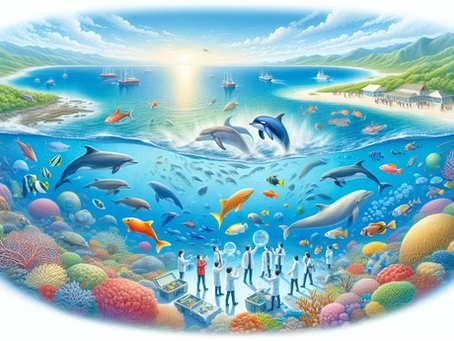Introduction
Marine conservation is an urgent global priority, vital for protecting fragile ecosystems and ensuring a sustainable future for humanity. Public awareness campaigns are at the heart of this mission, inspiring action, influencing policy, and mobilizing communities to protect marine life. This article explores how education, technology, collaboration, and community engagement are transforming the fight for ocean health.
Key Takeaways
- Education and outreach cultivate environmental stewardship and strengthen conservation efforts.
- Innovative technologies like autonomous vehicles enhance marine protection and monitoring.
- Success stories in restoration highlight the positive impact of conservation initiatives.
- Citizen science empowers communities to actively safeguard ocean ecosystems.
- Addressing overfishing, pollution, and habitat destruction is crucial for marine resilience.
Diving Deep into Marine Life Conservation
Understanding the Ecosystem
Marine ecosystems are delicate networks where every species plays a critical role. Overfishing, pollution, and climate change disrupt food chains, damage reefs, and alter migration patterns. Effective conservation depends on recognizing these connections and preserving biodiversity as a whole, rather than focusing solely on individual species.
The Role of Education in Conservation
Education fuels lasting change by raising awareness, teaching practical skills, and fostering community stewardship. Campaigns and outreach programs empower individuals—from students to sailors—to protect oceans through informed, sustainable actions. Each lesson shared creates ripples of change that contribute to healthier seas.
Innovative Technologies for a Sustainable Future
Technology is revolutionizing marine conservation. Artificial intelligence helps predict ecosystem changes and optimize strategies, while satellite monitoring tracks illegal fishing and habitat loss. These advancements accelerate a transition to sustainable practices and a circular economy, ensuring oceans remain resilient for future generations.
Making Waves with Wildlife Protection
The Plight of Marine Species
Pollution, overfishing, and habitat destruction are driving species declines. Yet, conservation initiatives are showing progress, with improved management and restoration projects reviving fragile populations. Raising awareness remains the first step in reversing these threats.
Success Stories in Recovery
Examples of resilience include coral reefs rebounding under protection, fisheries managed sustainably, and seagrass meadows restored with remarkable growth. These achievements prove that coordinated action yields tangible ecological and economic benefits.
Collaborative Efforts
From local beach cleanups to international partnerships, collaboration fuels conservation. Citizen science and community engagement strengthen ties to the ocean, while global cooperation amplifies the reach of sustainable practices and technological innovation.
Charting the Course for Conservation Strategies
International Policies and Agreements
Global frameworks such as the UN Decade on Ecosystem Restoration align nations to protect marine resources. Commitments to reduce carbon emissions and regulate consumption highlight the critical role of policy in shaping conservation outcomes.
Sustainable Fishing
Sustainable fishing practices—quotas, seasonal closures, and anti-IUU enforcement—balance food security with ecosystem health. These measures safeguard fish stocks while sustaining coastal economies.
The Rise of Marine Sanctuaries
Marine sanctuaries offer protected habitats for biodiversity, serve as natural laboratories, and support eco-tourism. Community involvement in sanctuary management ensures long-term success and shared stewardship.
Riding the Tide of Citizen Science
Citizen science empowers communities to protect marine habitats through surveys, cleanups, and monitoring. Initiatives like seagrass restoration and coral care demonstrate how local participation drives measurable conservation outcomes, strengthening both ecosystems and community bonds.
Navigating the Challenges Ahead
Climate Change
Rising temperatures and ocean acidification pose significant threats, altering ecosystems and endangering marine life. Reducing emissions, adopting renewable energy, and advancing restoration projects are essential to building resilience.
Policy and Practice
Strong governance ensures conservation goals are achieved. Tackling key environmental issues with coordinated strategies creates lasting frameworks for sustainable ocean management.
The Future of Advocacy
Digital platforms and social media amplify awareness, engaging younger generations and empowering communities to adopt ocean-friendly practices. Everyday actions, from reducing plastic use to choosing sustainable seafood, shape the future of advocacy.
Celebrating Coral Reefs
Coral reefs, home to a quarter of marine species, are biodiversity hotspots and economic lifelines. Restoration efforts, public education, and reef-safe practices help protect these vital ecosystems. By combining science with community action, reefs can thrive despite mounting threats.
Unveiling the Threats to Marine Life
- Overfishing: Depletes stocks and destabilizes food webs, requiring sustainable practices and stronger enforcement.
- Habitat Destruction: Destroys ecosystems like reefs and seagrass beds, undermining biodiversity and livelihoods.
- Pollution: Plastics, chemicals, and runoff poison marine life and disrupt ecological balance.
Exploring Marine Protected Areas
MPAs demonstrate measurable success in restoring ecosystems and species. Autonomous vehicles enhance monitoring and enforcement, while community involvement ensures long-term effectiveness and shared responsibility.
Tackling Plastic Pollution
Plastic Waste
Global campaigns, bans, and innovations are combating the flow of plastic into oceans. Cleanup projects and recycling advances drive progress toward a plastic-free future.
Microplastics
Microplastics infiltrate ecosystems worldwide, threatening marine life and human health. Prevention, research into alternatives, and global cooperation are critical to addressing this challenge.
Conclusion
Marine conservation is more than a campaign—it is a shared mission for survival. Education, innovation, collaboration, and citizen action form the backbone of ocean stewardship. By turning awareness into action, humanity can safeguard marine ecosystems and pass on thriving oceans to future generations.
Frequently Asked Questions
- What is marine life conservation? A holistic effort to protect and sustain ocean ecosystems vital to life on Earth.
- How does education support conservation? It spreads awareness, builds skills, and fosters environmental stewardship.
- What are examples of recovery success? Coral reef restoration, sustainable fisheries, and seagrass growth projects.
- Why are international agreements important? They align nations on shared goals for sustainable marine management.
- What role does citizen science play? It empowers communities to actively participate in monitoring and protection.
- What challenges exist? Overfishing, pollution, climate change, and weak enforcement undermine progress.
- How do AUVs help MPAs? They monitor ecosystems, enforce protections, and collect vital research data.
- Why are plastics a threat? Plastics and microplastics harm biodiversity and enter food chains worldwide.

